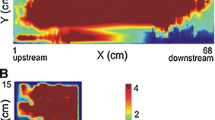Summary
-
1.
The influence of oxygen on the direction of movement (aerotaxis) by the freshwater oligochaete, Tubifex sp., was investigated by monitoring the behaviour of adult animals in different oxygen gradients.
-
2.
The results show that Tubifex expresses negative aerotaxis, i.e. moves away from oxygen, with preference for anoxia.
-
3.
The time course of Tubifex movements in oxygen gradients shows that the mechanism of aerotaxis is both sensitive and fast. This suggests that Tubifex possesses some kind of oxygen sensor by means of which it is able to recognize even small oxygen gradients.
Similar content being viewed by others
References
Alsterberg G (1922) Die Respiratorischen Mechanismen der Tubificiden. Lunds Univ Årsskr 18:1–222
Brinkhurst RO, Kennedy CR (1965) Studies on the biology of the tubificidae (annelida, oligochaeta) in a polluted stream. J Anim Ecol 34:429–443
Chua KE, Brinkhurst RO (1973) Evidence of interspecific interactions in the respiration of tubificid oligochaetes. J Fish Res Can 30:617–622
Collier JG (1947) Relations between metabolism and morphogenesis during regeneration in Tubifex tubifex I. Biol Bull 22:167–177
Dausend K von (1931) Über die Atmung der Tubificiden. Z Vergl Physiol 14:557–608
Engelmann TW (1881) Neue Methode zur Untersuchung der Sauerstoffausscheidung pflanzlicher und tierischer Organismen. Pflügers Arch Gesamte Physiol Menschen Tiere 25:285–292
Famme P, Knudsen (1984) Total heat balance study of anaerobiosis in Tubifex tubifex (Müller). J Comp Physiol 154: (in press)
Fenchel TM, Riedl RJ (1970) The sulfide system: a new biotic community underneath the oxidized layer of marine sand bottoms. Mar Biol 7:255–268
Fox HM (1955) The effect of oxygen on the concentration of haem in invertebrates. Proc Roy Soc B 143:203–214
Fox HM, Taylor AER (1955) The tolerance of oxygen by aquatic invertebrates. Proc Roy Soc B 143:215–225
Knudsen J, Famme R, Hansen ES (1983) A microcalorimeter system for continous determination of the effect of oxygen on aerobic-anaerobic metabolism and metabolite exchange in small aquatic animals and cell preparations. Comp Biochem Physiol 74A:63–66
Koenen M-L (1951) Vergleichende Untersuchungen zur Atmungs-physiologie von Tubifex tubifex M und Limnodrilus claparedeanus R. Zeitschr Vergl Physiol 33:436–456
Macnab RM (1982) Sensory reception in bacteria. Symp Soc Exp Biol 77–104
Palmer MF (1968) Aspects of the respiratory physiology of Tubifex tubifex in relation to its ecology. J Zool Lond 154:463–473
Thienemann A von (1920) Untersuchungen über die Beziehungen zwischen dem Sauerstoffgehalt des Wassers und der Zusammensetzung der Fauna in norddeutschen Seen. Arch f Hydrobiol 12:16–65
Weber RE (1978) Respiration. In: Mill PJ (ed) Physiology of annelids Academic Press, London, pp 369–392
Author information
Authors and Affiliations
Rights and permissions
About this article
Cite this article
Famme, P., Knudsen, J. Aerotaxis by the freshwater oligochaete Tubifex sp.. Oecologia 65, 599–601 (1985). https://doi.org/10.1007/BF00379679
Received:
Issue Date:
DOI: https://doi.org/10.1007/BF00379679




